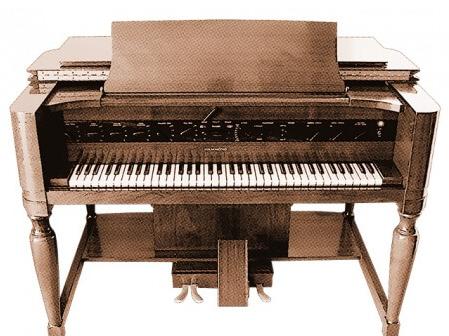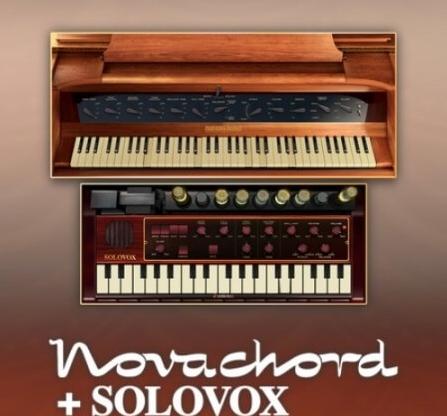Cherry Audio Novachord v1.0.2.21 WiN
Soft / VST Instruments / VST Effects
12-07-2023

Notorious
Manufactured by the Hammond company from 1939 to 1942 and debuting at the World’s Fair, the Novachord contained 163 vacuum tubes and over 1,000 custom capacitors. Its divide-down oscillator architecture combined full 72-key polyphony with an early version of analog subtractive synthesis. The Novachord’s architecture predicted the ADSR envelope, utilized a resonant band-pass filter, and included a vibrato unit. These now-familiar methods resemble designs adopted decades later in Moog and ARP polyphonic synthesizers.
Despite its historical importance, the Novachord did not enjoy commercial success. Although it resembled a standard organ at a glance, the front panel controls were not well-suited to the performance techniques of organists or pianists of the period. In addition, the numerous vacuum tubes were unstable, making the 500-pound instrument challenging to maintain. Production stopped in 1942 because of poor sales and parts shortages during the Second World War, with Hammond only manufacturing around 1,000 Novachords.
Nevertheless, the instrument was used for decades on many notable era recordings, such as We’ll Meet Again by Vera Lynn and Brother Bones’s Sweet Georgia Brown. It was also prominently featured in film soundtracks including the intermission for "Gone With the Wind” and in the scores of "Rebecca,” "The Maltese Falcon,” and "The Ten Commandments.” But it is best remembered for its otherworldly sound as heard in horror and sci-fi genre productions such as "Cat People,” "The Beast From 20,000 Fathoms,” "20 Million Miles to Earth,” and "The Gorgon.” On television, the Novachord remained a favorite of composers including Jerry Goldsmith and Harry Lubin in their work for The Twilight Zone and The Outer Limits, respectively. Today, fewer than 200 Novachords exist, and it is said that only five remain in operation.
Novachord Features:
32 polyphonic voices, synthesized not sampled.
Three Resonators: a resonant bandpass filter network operating consecutively in low (400 Hz), mid (800 Hz), high (2000 Hz) frequency ranges.
Deep Tone setting for the tone generator signal, with a one-pole (6dB per-octave slope) lowpass filter with a fixed frequency of 160 Hz.
Brilliant Tone setting for the tone generator signal, with a one-pole (6dB per-octave slope) highpass filter with a fixed frequency of 2000 Hz.
Full Tone setting controls the amplitude of the dry (no filters applied) tone generator signal.
Tones routed in parallel to all of the filters, processed and then summed together to create a composite tone.
Attack knob with seven Attack/Decay/Sustain envelope options, from Slow to Fast, with sustain-pedal controlled release (approximately3.5 seconds).
Adjustable depth vibrato with two options: Vibrato I as used in the earliest Novachord models, and Vibrato II as used in later Novachords.
Integrated reverb effect with Room and Hall algorithms plus speaker emulation to replicate the Novachord's built-in amp and speakers in an acoustic space.
56 presets covering Basses, Keys, Pads, and Strings, by Director of Sound Design James Terris.
Standard for Both Instruments:
Complete MIDI control and DAW automation for all controls, with easy-to-use MIDI learn and mapping (Preset and Global).
Cherry Audio's popular Focus zoom-in feature, as well as standard UI zoom and resize via drag.
Complete documentation available directly online from the instrument or in downloadable PDF format.
User-adjustable oversampling control.
home page:
https://goo.su/D22TdZ
Manufactured by the Hammond company from 1939 to 1942 and debuting at the World’s Fair, the Novachord contained 163 vacuum tubes and over 1,000 custom capacitors. Its divide-down oscillator architecture combined full 72-key polyphony with an early version of analog subtractive synthesis. The Novachord’s architecture predicted the ADSR envelope, utilized a resonant band-pass filter, and included a vibrato unit. These now-familiar methods resemble designs adopted decades later in Moog and ARP polyphonic synthesizers.
Despite its historical importance, the Novachord did not enjoy commercial success. Although it resembled a standard organ at a glance, the front panel controls were not well-suited to the performance techniques of organists or pianists of the period. In addition, the numerous vacuum tubes were unstable, making the 500-pound instrument challenging to maintain. Production stopped in 1942 because of poor sales and parts shortages during the Second World War, with Hammond only manufacturing around 1,000 Novachords.
Nevertheless, the instrument was used for decades on many notable era recordings, such as We’ll Meet Again by Vera Lynn and Brother Bones’s Sweet Georgia Brown. It was also prominently featured in film soundtracks including the intermission for "Gone With the Wind” and in the scores of "Rebecca,” "The Maltese Falcon,” and "The Ten Commandments.” But it is best remembered for its otherworldly sound as heard in horror and sci-fi genre productions such as "Cat People,” "The Beast From 20,000 Fathoms,” "20 Million Miles to Earth,” and "The Gorgon.” On television, the Novachord remained a favorite of composers including Jerry Goldsmith and Harry Lubin in their work for The Twilight Zone and The Outer Limits, respectively. Today, fewer than 200 Novachords exist, and it is said that only five remain in operation.
Novachord Features:
32 polyphonic voices, synthesized not sampled.
Three Resonators: a resonant bandpass filter network operating consecutively in low (400 Hz), mid (800 Hz), high (2000 Hz) frequency ranges.
Deep Tone setting for the tone generator signal, with a one-pole (6dB per-octave slope) lowpass filter with a fixed frequency of 160 Hz.
Brilliant Tone setting for the tone generator signal, with a one-pole (6dB per-octave slope) highpass filter with a fixed frequency of 2000 Hz.
Full Tone setting controls the amplitude of the dry (no filters applied) tone generator signal.
Tones routed in parallel to all of the filters, processed and then summed together to create a composite tone.
Attack knob with seven Attack/Decay/Sustain envelope options, from Slow to Fast, with sustain-pedal controlled release (approximately3.5 seconds).
Adjustable depth vibrato with two options: Vibrato I as used in the earliest Novachord models, and Vibrato II as used in later Novachords.
Integrated reverb effect with Room and Hall algorithms plus speaker emulation to replicate the Novachord's built-in amp and speakers in an acoustic space.
56 presets covering Basses, Keys, Pads, and Strings, by Director of Sound Design James Terris.
Standard for Both Instruments:
Complete MIDI control and DAW automation for all controls, with easy-to-use MIDI learn and mapping (Preset and Global).
Cherry Audio's popular Focus zoom-in feature, as well as standard UI zoom and resize via drag.
Complete documentation available directly online from the instrument or in downloadable PDF format.
User-adjustable oversampling control.
home page:
https://goo.su/D22TdZ
Related articles
 Cherry Audio Solovox v1.0.3.21 WiN
Cherry Audio Solovox v1.0.3.21 WiN
Soft / VST Instruments / VST Effects
12-07-2023
The Solovox, manufactured by Hammond between 1940 and 1950, was another classic instrument of the era. Based on the Novachord’s oscillator and divider circuits, the Solovox with its 18 vacuum tubes was a small monophonic keyboard instrument attached beneath a piano keyboard and intended to augment it with organ-type lead voices. It consisted of two units: the three-octave mini keyboard, and a tone cabinet for the electronic sound generator, amplifier, and loudspeaker. Like the Clavioline and Ondioline, the Solovox produced a range of string, woodwind, and organ sounds and was widely used in light music from the 1940s and into the 1960s. Unfortunately, the introduction of compact transistor organs released in the 60s marked the end of the Solovox’s popularity.
VST Effects / VST Plugins / Audio Soft
11-03-2023
The Sleeper Has Awakened
Mercury-6 is a meticulous recreation of the Jupiter-6 analog synthesizer, just in time for its 40th anniversary! Sandwiched between the earlier Jupiter-4 and Jupiter-8 models in name only, the sophisticated Jupiter-6 has sometimes been considered a sleeper release.
These days, it has persevered to become one of Roland's most notable and coveted classic synthesizers due to its distinctive dark and complex character. Mercury-6 captures all that is exceptional in this treasured polyphonic classic, boosts its extraordinary feature set for today's DAW production and workflow, and celebrates the ground-breaking innovation from the era that changed music forever.
VST Effects / VST Plugins / Audio Soft
17-04-2022
There is nothing analog about a Rack Extension, so why pretend. The Digital Filter takes full advantage of modern signal processing techniques and for the first time provides Continuously Variable Slope. You can now morph between the classic response of a 4-pole filter (Moog), to the subtle sounds of a 2-pole filter (Oberheim), and for an extremely steep cutoff all the way up to a 12-pole filter. And everything in between, you can even play with odd order filters if you like. It's shaping up to be the only filter you'll need in your toolbox, though you might want more than one instance.
VST Instruments / VST Plugins / Audio Soft
31-12-2021
Pentagon I gives you the warm, classic sound of the vintage analog synthesizers, combined with the fidelity and precision of virtual instruments. Pentagon I is powerful, and packed with features that offer uncompromised sound quality, with a comfortable and easy to use interface.
4 Oscillators, 13 Alias Free Waveforms each plus a Noise Generator per oscillator:
Saw
Vintage Saw
Square